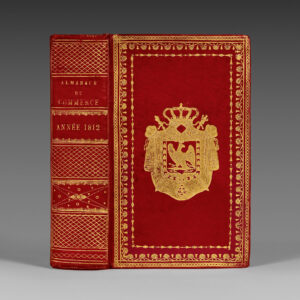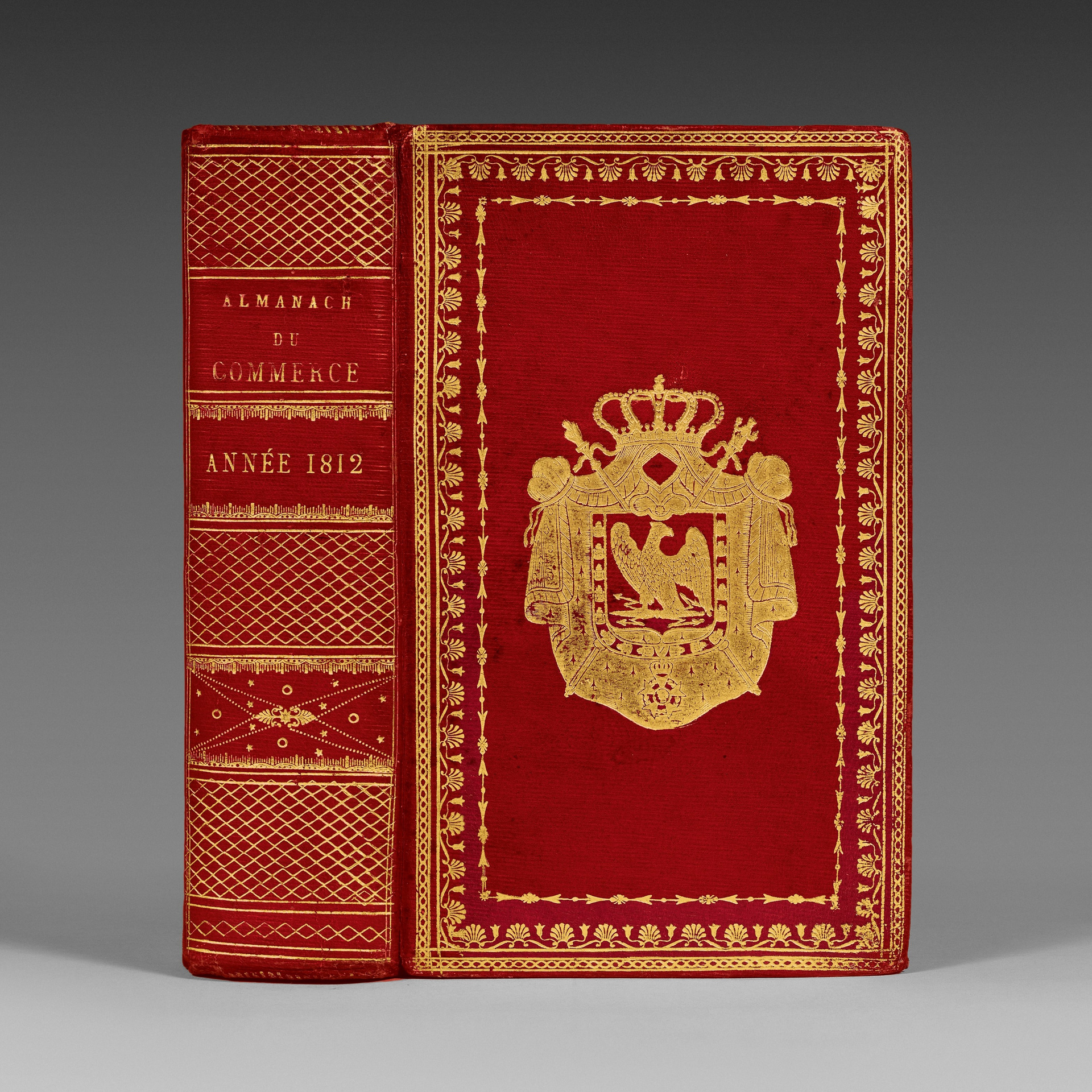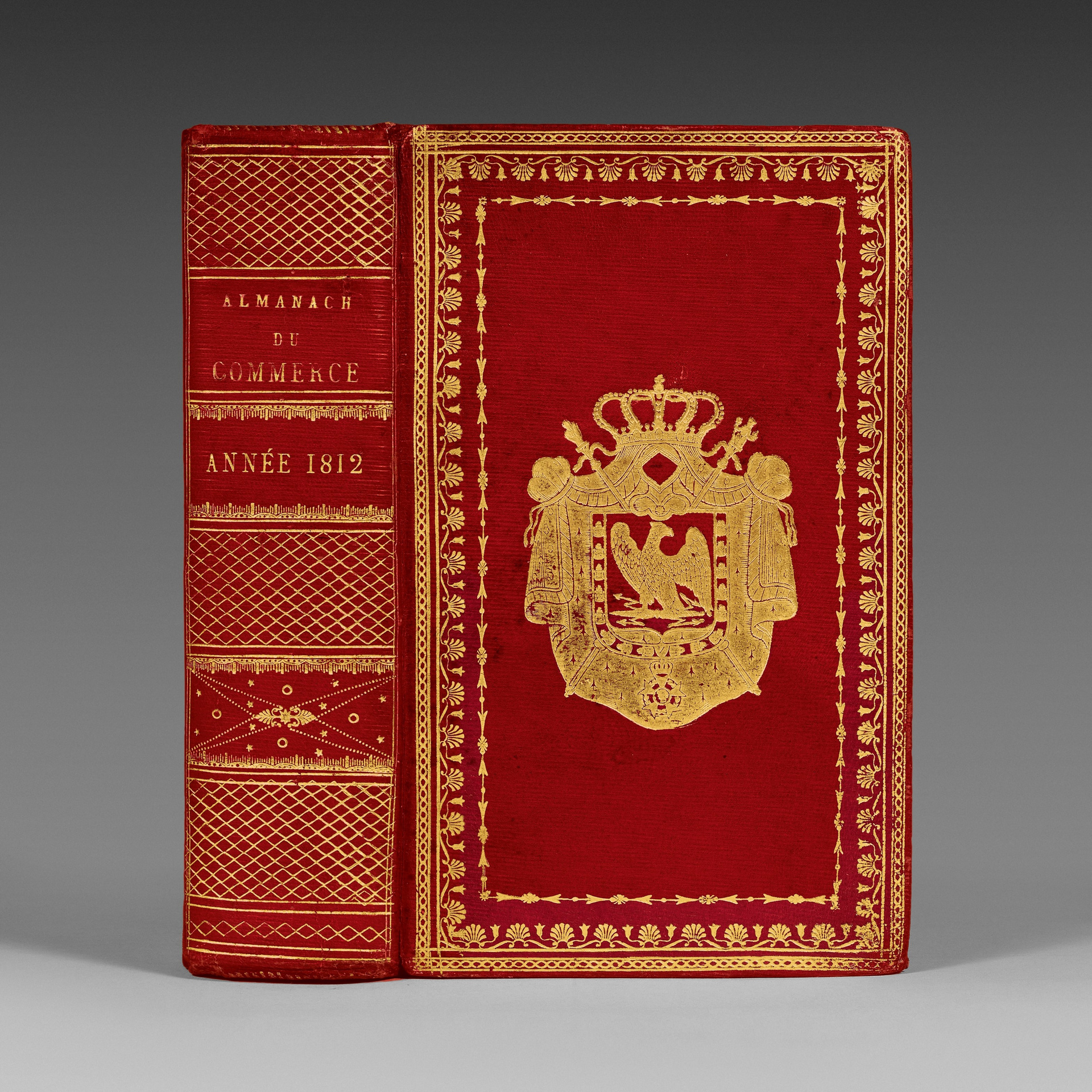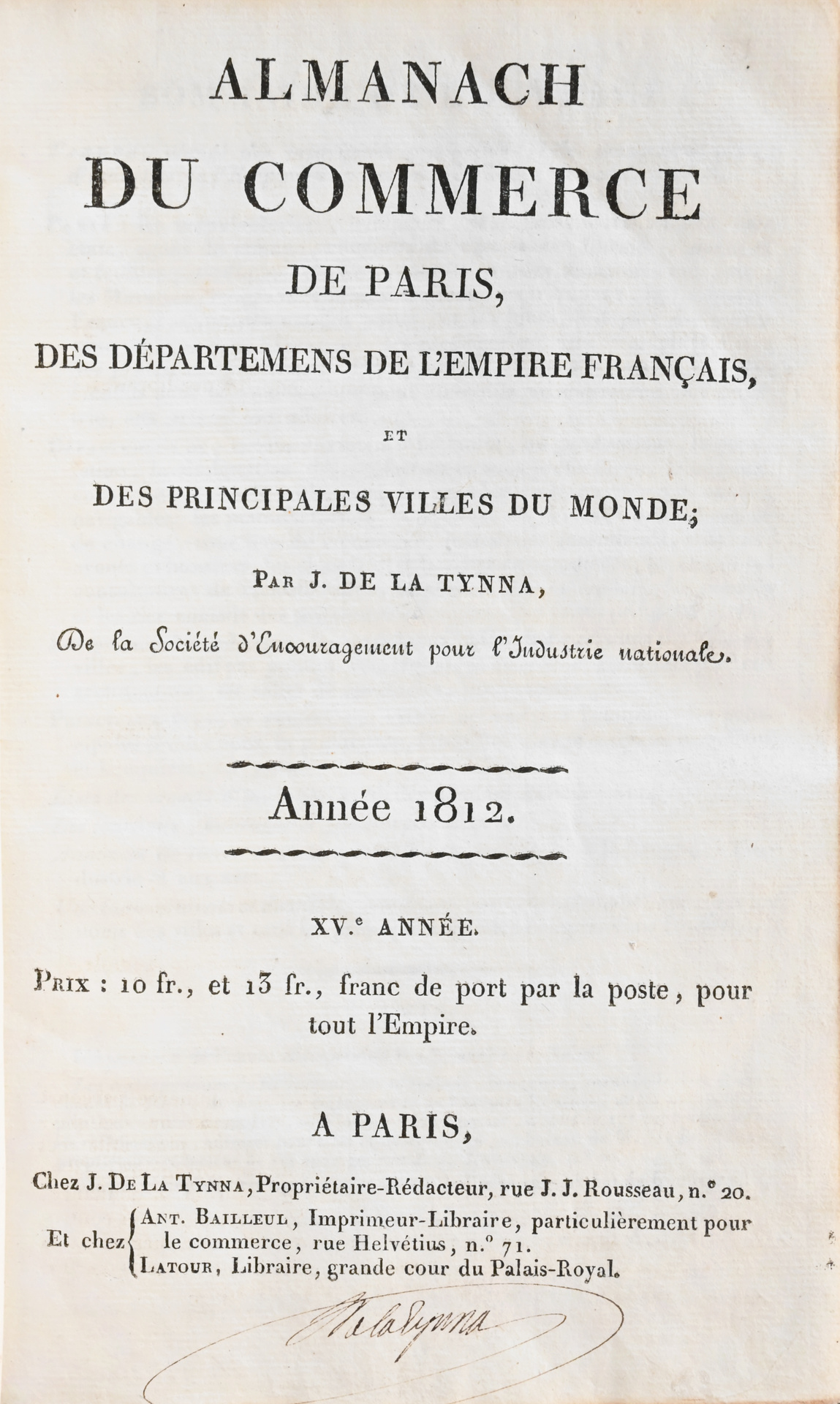8vo [211 x 129 mm] of 1039 pp. Full red morocco, gilt framing of fillets and border around the covers, arms of the Emperor Napoléon in the center of the covers, flat spine richly decorated, doublures and endleaves in blue watered silk, gilt edges. Contemporary armorial binding.
The Trade Almanac for the year 1812 contemporary bound with the arms of the Emperor Napoleon.
It presents the “Abbreviated Table of the principal productions and principal objects of industry of the French Empire; its extent, population, etc.
Paris: manufacturers, bankers, negotiators, merchants of all states, agents of exchange, commercial brokers, booksellers, newspapers and periodical sheets, notaries, lawyers, solicitors, ushers, etc., etc.,; the Ministers, the grand administrations, the courts, the Bank of France, the postal administrations, and the days of departure of letters for France and Overseas, couriers, a particular list of the principle habitants of Paris; finally, the most extensive information of which the knowledge may be useful to commerce, industry, arts and business.
Departments of the French Empire: the extent, the productions, the populations, the designation of the prefectures, sub-prefectures, courts, conservation of mortgages; major roads, rivers and navigable canals; manufacturers, bankers, merchants, booksellers, agents of exchange, commercial brokers, principal merchants, notaries, solicitors and ushers; the chambers and stock of manufacturers, advisory chambers of manufacturers, factories, arts and cragts; consuls and vice-consuls of foreign power; the main fairs, etc.
The main inns; the main cafes; the curiosities of large cities public buildings remarkable for their antiquity or architecture; theaters, walks, etc.
Main states and main cities of the world: the extent, the principal productions, the population, the industry, the principal merchants and bankers, etc., etc.
List of patents granted during the year 1811.
Newspapers, books and periodicals.
Announcements of new books relating to commerce, the bank, the industry and the arts.
A general and detailed table containing, in alphabetical order, all the names of the cities and all the main articles included in the work.”
We learn, for example, that the Empire of China “occupies an area of nearly 830,000 square leagues”, that “its population is estimated at 100,000,000 inhabitants, of which 30,000,000 belong to Tibet, Korea and other countries from the North and West, now united to this empire”. That their main productions are rice, wheat, millet, vegetables, fruits, silk, cotton, wool, tea, honey, wax, tobacco, rhubarb, camphor, musk, amber, gold, copper, iron, steel, tin, eagle wood, ironwood, bamboo, etc.
Regarding China’s trade: “domestic trade is very flourishing; but with the exception of the only port of Canton, or the only article of tea, foreign trade, though fairly extensive, is not proportionate to the population of the empire and the wealth of its productions. The trade with Batavia and Manila has some activity; the one with Japan is only tolerated. The English and the Americans are pretty much the only Western people who are now trading with China. They carry money in piasters and bars, sheets of Europe, wines, elephant teeth, clockwork, etc.
They make tea, silk stuffs, stuffed or spun cotton, cotton and hemp cloth, fine gold, yellow copper, porcelain, varnished articles, ink, shellac, white silk … and by caravans crossing the Russian provinces, tea and silk stuffs. Twenty seven million pounds of tea are consumed annually in Europe and the USA, of which more than half in England.”
Or, that in the United States of America, the population consists of:
– free men……………..……… 5,156,000
– slaves…………………………1,024,900
– Free, coloured men…… …….131,000
Total : …………….…………..6,311,900 inhabitants, etc.
Very beautiful copy contemporary bound with the arms of the Emperor Napoleon 1st.
Napoléon Bonaparte, second son of Charles-Marie and Marie-Laetitia Ramolino, born in Ajaccio on August 15, 1795 ; promoted to second lieutenant in 1785, he rose quickly in rank and was already general of division in 1795 ; on March 9, 1796, he married Marie-Josephine-Rose Tascher de la Pagerie, widow of the Viscount of Beauharnais, a few days after being appointed Commander-in-Chier of the army of Italy; having overthrew the Directory by the coup of the 18th Brumaire year eight (November 9th, 1799), he was appointed First Consul for ten years (December 24th, 1799), then consul for life on August 2, 1802; he was proclaimed Emperor of the French by the senate in 1804, and was consecrated to Our Lady under the name of Napoléon I by Pope Pius VII, on December 2 of the same year; in 1805, having established the Cisalpine republic as a kingdom, he had himself crowned king of Italy at Milan; a year later in 1806 he took the title of protector of the Confederation of the Rhine.
The always victorious campaigns of Napoleon against the powers of coalesced Europe, earned France an exaggerated enlargement; the neighboring countries were ruled by brothers of the emperor who married on April 2, 1810, the Archduchess Marie-Louise-Leopoldine-Françoise-Thérèse-Josèphe-Lucie of Austria daughter of the Emperor Francis I, after having to break his marriage with the Empress Josephine on December 16, 1809, for sterility. But Napoléon’s ambition caused his loss, and the armies of Europe, all of whom were raised against him, invaded France and forced him to abdicate at Fontainebleau on April 11, 1814, in favor of his son and to accept the island of Elba in all sovereignty (May 3, 1814). The faults of the Restoration encouraged him to return to France (March 1st, 1815); he resumed power after a triumphal return (March 20), but was immediately outlawed by Europe; beaten at Waterloo on the 18th of June, 1815. Napoléon, after a reign of 100 days, abdicated a second time in favor of his son on June 22, 1815, went to Rochefort and sought refuge on the English ship “Bellerophon”. The English cabinet, abusing the situation, considered him a prisoner and had him transported to the island of St. Helena (17 October, 1815) where died on May 5, 1812.




